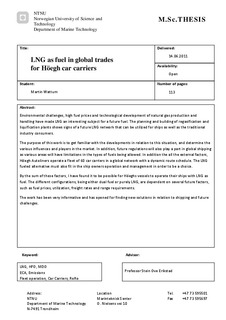| dc.description.abstract | LNG shipping is tracking back to the 1950s, and has for more than half a century been finding promising. It is not until the last years LNG has been taken into commercial shipping as a fuel, and more widely considered a future main source of energy. This is due to important factors such as shale gas production together with increasing oil prices and pressure for green fuel by states and authorities. Within the new 10 year period, several key harbor areas will have strict limitations in term of fuel being used by the ships.
There are various technical solutions on the market to reduce the emissions from an oil fueled engine. However, as the oil price is predicted to further increase a change of energy source could be profitable.
LNG has a lower energy density than fuel oil and requires also tank isolation to keep it at -163°C. Together with limitations in where it can be installed in the vessel from the class societies makes it less energy dense as similar amounts of bunker oil. This is considered one of the main disadvantages for it to be used in ships.
As found, there are solutions that can be used in order to overcome the downside of LNG being less energy dense than fuel oil. This can be as I have found, to either increase the number of bunkering operations, the governments can install offshore bunkering stations, and one can either take space from cargo decks, redesign ship volumes, or add configurations for removable LNG tanks onboard, used when sailing longer distances. Ongoing development in membrane tanks will also increase the energy density, together with changes in the classification societies rules and regulations.
From studying the ship operation pattern and engine loads, I found that the consumption of fuel oil compared to fuel oil volumes is relatively low. Today, the vessels have a capacity of sailing for about 2 months without bunkering. Still, I have seen and experienced that a bunkering operation is not an issue, and only requires some additional planning. On this basis and picture of the general arrangement and stability data I have found different solutions that will have different effects depending on several factors, such as future fuel price and operational pattern.
In the lean burn gas solution, the design would have to take a volume of 1.500 [m3] from the cargo space to be able to reach between the longest sea stretches, being from Japan to South America. The cost of lost opportunity will depend highly of the degree of utilization of deck 1. As long as it is under 65%, there will be no cost of lost opportunity. Utilization over this will give an added cost, depending of the freight rates and utilization degree. I found that this solution actually would be profitable as long as LNG is about 10% cheaper than HFO for assumptions regarding operation profile and the mentioned utilization and rates. Since the LNG 2-stroke engine is significantly decreasing in efficiency below 60-70% load, it is likely to be beneficial with shaft generators installed. The size of the main engine would again depend on load and operation.
Another solution is to add extra fuel tanks when crossing the pacific. This will not result in a cost of lost opportunity if the vessel is sailing in other trades. This concept would also be easily loaded and discharged as the tanks can be rolled on and off, with the ramp supporting 150 tons.
The other solution I found is that the existing bunker tank volume included in Höeghs ships is sufficient for the vessel to operate on a dual fuel configuration, with more than 400 tons LNG and 675 tons HFO onboard. If it is possible to add HFO in the volume underneath the LNG-tanks, the total volumes of the two fuels could be 500 tons LNG and 1900 tons of fuel oil. The dual fuel engines are said to be 4% less efficient from statement from engine makers, when operation on HFO mode compared to a pure diesel engine.
In conclusion, the dual fuel design is profitable if the LNG costs are between MDO and HFO-price, and the design will also add values that might also give motivation behind the choice, such as redundancy in the fuel system and a lower climate footprint. If the LNG price is lower than HFO, a purely LNG solution is found to be most likely economical. | nb_NO |
